________________
"Concept of Rasa" as seen in Anandavardhana and......
"vyāghra"dayo vibhāvā bhayānakasya iva vīrā'dbhuta-raudrāṇam, aśrupātā❞dayo'nubhāvāḥ śṛngārasya iva karuṇa-bhayānakayoḥ, cinta"dayo vyabhicāriṇaḥ śṛngārasya iva vīra-karuṇa-bhayānakānām iti pṛthag anaikantikatvāt sūtre mīlitā nirdiṣṭāḥ."
(Trans. R. C. Dwivedi, pp. 75, ibid) :
"The determinants, tiger and the like, belong to the Heroic, the Wonderful and the Furious, as to the Terrific; the ensuants like the fall of tears belong to the Pathetic and the Terrific, as to the Erotic; the transitories like anxiety to the Heroic, the Pathetic and the Terrific, as to the Erotic. As these are not exclusive (to any particular rasa), they have been mentioned together in the aphorism (of Bharata).
1337
M. mentions the eight rasas as read in Bharata and also mentions śānta, the ninth, half-heartedly. M. observes (K.P. IV. 35 a) (pp. 88, ibid)
"nirveda-sthāyibhāvā"khyaḥ
śāntópi navamo mataḥ."
"Quietism also is the ninth rasa with detachment as its basic emotion." This M. does perhaps under the influence of the DR. of Dhananjaya.
Hemacandra follows the lead of the great three i.e. Anandavardhana, Abhinavagupta and Mammața. His disciples Ramacandra and Gunacandra beg to differ in some respect from the Kashmir School of thought.
It may be noted that Hemacandra (= H.) in his learned commentary termed 'Viveka' on his own Kāvyánuśāsana, has virtually paraphrased the whole of Abhinavabhāratī on the rasa-sūtra and other portions connected with rasa, bhāva etc. He has therefore preserved very reliable readings from the original A.bh. that was available to him. It is therefore that Gnoli, and even Masson and Patwardhan have preferred readings from the A.bh. as presented by H. in his Viveka. Actually my Guru Dr. V. M. Kulkarni has given the reconstructed text of the missing portion of the A.bh. on the Bhāvádhyāya i.e. Ch. VII of the N.S. Actually H.'s viveka is the most reliable research tool for fixing up of actual readings from various sources which include not only the great works on Alamkāra such as the Vyaktiviveka of Mahimabhaṭṭa, but also the great literary works such as those of Kālidāsa. Actually in separate research papers read at various venues we have tried to fix up the variants as read in the works of
Jain Education International
For Personal & Private Use Only
www.jainelibrary.org




